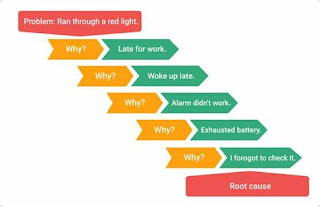 |
| 5 Why diagram |
5 Whys Diagram: A Step-by-Step Guide with Real-Life Example
As product owners, UX researchers, and problem-solvers, we encounter challenges that demand more than surface-level fixes. When issues arise, it’s essential to dig deep and uncover the underlying causes. Enter the 5 Whys—a simple yet potent tool that peels away layers of complexity to reveal the core problems. In this article, we’ll explore the 5 Whys template, understand its significance, and illustrate its application with real-world examples.
What Is the 5 Whys Technique?
The 5 Whys is a structured approach used to identify the root cause of a problem by asking “why” repeatedly. By delving into the layers of causality, teams gain insights beyond symptoms and address issues at their source. Let’s break down the process:
Identify the Key Issue or Problem:
- Clearly define the problem you’re tackling. What’s the main issue affecting your process or outcome?
- Quantify or measure the problem to make it measurable.
- Consider the impact of the problem on your desired results.
- Determine when the problem started (time frame) and where it occurred (location).
- Identify the people or groups involved or affected by the problem.
Ask the First ‘Why?’:
- Why did the problem occur? Start the analysis process.
- Uncover the initial cause and validate it.
Ask the Second ‘Why?’:
- Dig deeper into the root cause. Why did the identified cause happen?
- Validate the second-level cause.
Ask the Third ‘Why?’:
- Continue tracing back. What secondary cause led to the initial issue?
- Validate the third-level cause.
Ask the Fourth ‘Why?’:
- Trace all the way to the root cause. Why did the secondary cause occur?
- Validate the fourth-level cause.
Ask the Fifth ‘Why?’ (If Necessary):
- Confirm and validate the ultimate cause, if identified.
Document Findings and Conclusions:
- Record the root cause and insights.
- Implement suitable corrective measures.
- Monitor the outcomes of your actions.
Why Should You Use the 5 Whys Template?
Identify Root Causes:
- The 5 Whys method goes beyond symptoms, revealing the underlying issues.
- It ensures effective solutions by targeting the source of the problem.
Improve Problem-Solving Skills:
- Critical thinking thrives as you peel back layers systematically.
- Informed decision-making leads to better outcomes.
Real-World Examples:
Website Downtime:
Issue: Frequent website crashes.
- 1st Why: Why does the website crash? (Server overload.)
- 2nd Why: Why is the server overloaded? (Insufficient capacity.)
- 3rd Why: Why is capacity insufficient? (Underestimated traffic.)
- 4th Why: Why was traffic underestimated? (Lack of historical data.)
- 5th Why: Confirm data deficiency and address it.
High Bounce Rates on a Landing Page:
Issue: Visitors leave immediately.
- 1st Why: Why do visitors bounce? (Slow page load.)
- 2nd Why: Why is the page slow? (Large image files.)
- 3rd Why: Why use large images? (No image optimization.)
- 4th Why: Why no optimization? (Lack of awareness.)
- 5th Why: Educate the team on image optimization.
Remember, the 5 Whys isn’t about blame—it’s about understanding and improvement. So, next time you face a challenge, ask “why” and unravel the hidden truths behind it! 🚀







0 Comments